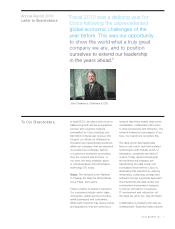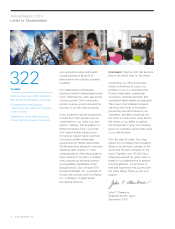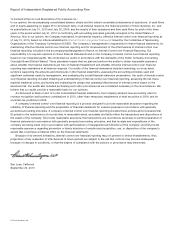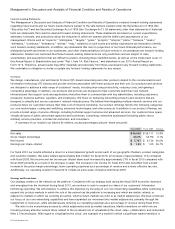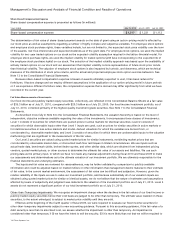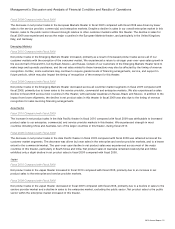Cisco 2010 Annual Report Download - page 13
Download and view the complete annual report
Please find page 13 of the 2010 Cisco annual report below. You can navigate through the pages in the report by either clicking on the pages listed below, or by using the keyword search tool below to find specific information within the annual report.Management’s Discussion and Analysis of Financial Condition and Results of Operations
• During the second quarter of fiscal 2010, we completed an offering of senior unsecured notes in an aggregate principal amount
of $5.0 billion.
• Our product backlog at the end of fiscal 2010 was $4.1 billion or 10% of fiscal 2010 net sales, compared with $3.9 billion at the
end of fiscal 2009 or 11% of fiscal 2009 net sales.
We believe that in any rapidly shifting supply and demand environment such as the one we experienced in fiscal 2010, shifts in lead
times, inventory levels, purchase commitments, and manufacturing outputs will occur. During fiscal 2010, we experienced longer
than normal lead times on several of our products and we continue to see challenges at some of our component suppliers. This
was attributable in part to increasing demand driven by the improvement in our overall markets. In addition, and similar to what is
happening throughout the industry, the longer than normal lead times also stemmed from supplier constraints based upon their
labor and other actions taken during the global economic downturn. While we may continue to experience longer than normal lead
times, our lead times improved on the majority of our products in the second half of fiscal 2010, and at the end of fiscal 2010,
product lead times to customers were within a normal range for the majority of our products. We have increased our efforts in
procuring components in order to meet customer expectations, which have contributed to an increase in purchase commitments. If,
however, lead times for key components lengthen further, our operating results for a particular future period could be adversely
affected if we further increase our purchase commitments, which could lead to excess and obsolete inventory charges.
Critical Accounting Estimates
The preparation of financial statements and related disclosures in conformity with accounting principles generally accepted in the
United States requires us to make judgments, assumptions, and estimates that affect the amounts reported in the Consolidated
Financial Statements and accompanying notes. Note 2 to the Consolidated Financial Statements describes the significant
accounting policies and methods used in the preparation of the Consolidated Financial Statements. The accounting policies
described below are significantly affected by critical accounting estimates. Such accounting policies require significant judgments,
assumptions, and estimates used in the preparation of the Consolidated Financial Statements, and actual results could differ
materially from the amounts reported based on these policies.
Revenue Recognition
Revenue is recognized when all of the following criteria have been met:
•Persuasive evidence of an arrangement exists. Contracts, Internet commerce agreements, and customer purchase orders are
generally used to determine the existence of an arrangement.
•Delivery has occurred. Shipping documents and customer acceptance, when applicable, are used to verify delivery.
•The fee is fixed or determinable. We assess whether the fee is fixed or determinable based on the payment terms associated with
the transaction and whether the sales price is subject to refund or adjustment.
•Collectibility is reasonably assured. We assess collectibility based primarily on the creditworthiness of the customer as determined
by credit checks and analysis, as well as the customer’s payment history.
In instances where final acceptance of the product, system, or solution is specified by the customer, revenue is deferred until all
acceptance criteria have been met. When a sale involves multiple deliverables, such as sales of products that include services, the
entire fee from the arrangement is allocated to each respective element based on its relative selling price and recognized when
revenue recognition criteria for each element are met.
In October 2009, the Financial Accounting Standards Board (FASB) amended the accounting standards for revenue recognition
to remove from the scope of industry-specific software revenue recognition guidance, tangible products containing software
components and nonsoftware components that function together to deliver the product’s essential functionality. In October 2009,
the FASB also amended the accounting standards for multiple-deliverable revenue arrangements to:
(i) provide updated guidance on whether multiple deliverables exist, how the deliverables in an arrangement should be
separated, and how the consideration should be allocated;
(ii) require an entity to allocate revenue in an arrangement using estimated selling prices (ESP) of deliverables if a vendor does
not have vendor-specific objective evidence of selling price (VSOE) or third-party evidence of selling price (TPE); and
(iii) eliminate the use of the residual method and require an entity to allocate revenue using the relative selling price method.
2010 Annual Report 11


